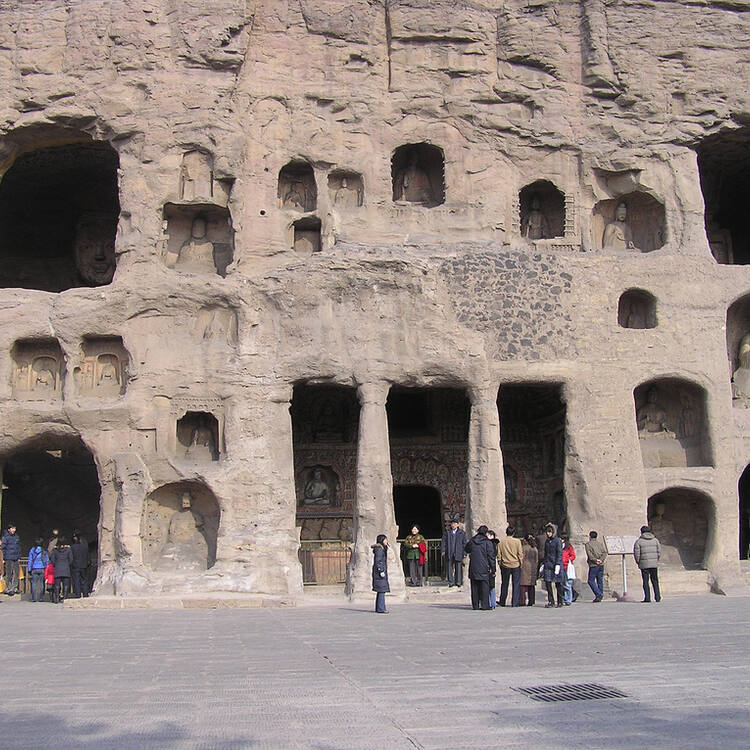Yungang Grottoes
Yungang Grottoes
The Yungang Grottoes, in Datong city, Shanxi Province, with their 252 caves and 51,000 statues, represent the outstanding achievement of Buddhist cave art in China in the 5th and 6th centuries. The Five Caves created by Tan Yao, with their strict unity of layout and design, constitute a classical masterpiece of the first peak of Chinese Buddhist art.
Description is available under license CC-BY-SA IGO 3.0
Grottes de Yungang
Les grottes de Yungang, à Datong, province du Shanxi, avec leurs 252 grottes et leurs 51 000 statues, représentent une réussite exceptionnelle de l'art rupestre bouddhique en Chine au Ve et au VIe siècle. Les Cinq Grottes, réalisées par Tan Yao avec une stricte unité du plan et de la conception, sont un chef d'œuvre classique de la première apogée de l'art rupestre bouddhique en Chine.
Description is available under license CC-BY-SA IGO 3.0
كهوف يونغانغ
تمثّل كهوف يونغانغ في داتونغ مقاطعة شانكسي، والمكوّنة من 252 كهفاً و51000 تمثال، نجاحاً استثنائياً لفنّ النحت البوذي في الصين في القرنين الخامس والسادس. أنجز تان ياو الكهوف الخمسة موحّداً بين الخطّة والتنفيذ وهي تشكل تحفةً كلاسيكيّةً للذروة الأولى للفنّ البوذي للنحت على الصخر في الصين.
source: UNESCO/CPE
Description is available under license CC-BY-SA IGO 3.0
云岗石窟
云岗石窟,位于山西省大同市,现存洞窟252座、石像51 000尊,代表了5世纪至6世纪时期中国高超的佛教艺术成就。“昙曜五窟”整体布局严整,风格和谐统一,是中国佛教艺术发展史的第一个巅峰。
source: UNESCO/CPE
Description is available under license CC-BY-SA IGO 3.0
Пещерные храмы Юньган
Пещерные храмы Юньган в городе Датун, провинция Шаньси, включающие 252 пещеры и 51 тыс. статуй, представляют выдающееся достижение буддийского пещерного искусства Китая V-VI вв. Пять пещерных храмов, созданных Тань Яо, отличающихся единством планировки и убранства, являют собой шедевры того времени, когда китайское буддийское искусство переживало свой первый расцвет.
source: UNESCO/CPE
Description is available under license CC-BY-SA IGO 3.0
Grutas de Yungang
Este sitio se halla cerca de la ciudad de Datong, en la provincia de Shanxi. Sus 252 grutas, ornadas con 51.000 estatuas, representan una realización excepcional del arte rupestre búdico en la China de los siglos V y VI. Las llamadas Cinco Grutas, realizadas por Tan Yao con una rigurosa unidad de trazado y diseño, son una obra maestra clásica del primer período de apogeo del arte budista en China.
source: UNESCO/CPE
Description is available under license CC-BY-SA IGO 3.0
雲崗石窟
source: NFUAJ
Yungang grotten
Source: unesco.nl
Outstanding Universal Value
Brief synthesis
The massive Yungang Buddhist grottoes were cut from the mid-5th Century to early-6th Century AD. Comprising 252 caves and niches and 51,000 statues within a carved area of 18,000 square meters, the Yungang Grottoes represent the outstanding achievement of Buddhist cave art in China. The Five Caves created by Tan Yao are a classical masterpiece of the first peak of Chinese art, with a strict unity of layout and design. The will of the State is reflected in Buddhist belief in China during the Northern Wei Dynasty since the Grottoes were built with Imperial instructions. While influenced by Buddhist cave art from South and Central Asia, Yungang Grottoes have also interpreted the Buddhist cave art with distinctive Chinese character and local spirit. As a result, Yungang Grottoes have played a vitally important role among early Oriental Buddhist grottoes and had a far-reaching impact on Buddhist cave art in China and East Asia.
Criterion (i): The assemblage of statuary of the Yungang Grottoes is a masterpiece of early Chinese Buddhist cave art.
Criterion (ii): The Yungang cave art represents the successful fusion of Buddhist religious symbolic art from south and central Asia with Chinese cultural traditions, starting in the 5th century CE under Imperial auspices.
Criterion (iii): The power and endurance of Buddhist belief in China are vividly illustrated by the Yungang grottoes.
Criterion (iv): The Buddhist tradition of religious cave art achieved its first major impact at Yungang, where it developed its own distinct character and artistic power.
Integrity
The statues housed in the caves and niches are in good condition and all of the caves and statues have not suffered major damage from vandalism and/or natural disasters. Restoration and repair had been made on deficient parts of some statues in the past. All the necessary attributes demonstrating the Outstanding Universal Value of Yungang Grottoes are contained within the boundary of the property area. The buffer zone provides a necessary safe area for the conservation of the Grottoes, the setting and the historic environment. These measures have enabled the Yungang Grottoes to serve as one of the greatest ancient stone carving art treasure houses in the world.
Authenticity
The location, caves and statues of the Yungang Grottoes have retained their historic appearance. The eaves of wooden pavilions of the caves and the related historical remains have kept the distinctive character of the times when they were constructed. The daily maintenance and conservation intervention have been conducted following the conservation principle of minimal intervention in design, materials, methodology, techniques and craftsmanship.
Protection and management requirements
The Yungang Grottoes were listed by the State Council among the first group of State Priority Protected Sites in 1961. A number of laws and regulations including the “Law of the People's Republic of China on the Protection of Cultural Relics”, the “Regulations of Datong Municipality on Protection and Management of Yungang Grottoes” and the “Conservation Master Plan of Yungang Grottoes”, have guaranteed the conservation and management of Yungang Grottoes.
A special organization (now known as the “Yungang Grottoes Research Academy”) and professional team have been established to carry out protection, monitoring and regular daily maintenance for the past six decades. The environmental improvement projects have been implemented in recent years at the surrounding villages based on the “Conservation Master Plan of Yungang Grottoes”, a commitment that the Chinese government has made in application for the inscription on the World Heritage List. Conservation intervention and maintenance have followed conservation principles, and some pilot protection programs have been carried out to counter the major threats including water seepage, rain erosion and weathering.
